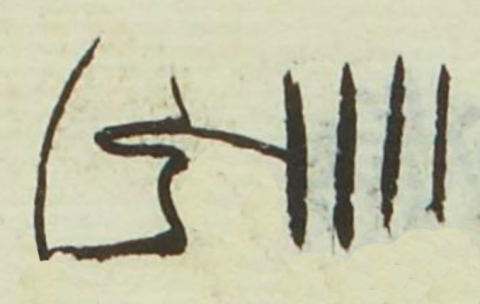Nauhtene (MH522v)
This black-line drawing combines the notation for the number four (nahui) with the simplex glyph for lip (tentli). The latter shows part of a face, with a focus on mouth and chin. The notation consists of four short upright lines meant to convey the number.
Stephanie Wood
These two elements provide most of what is needed for the name as glossed, Nauhtene. The dictionary entry that comes closest to this name is nauhteme, which has an "m" in place of the "n." The -me suffix may be a plural, and the -ten from tentli might have merged with the -me suffix. The lip element, however, could be there as a phonetic indicator and not play a semantic roll, because nauhtetl simply means four, and perhaps it has been seen as an animate and pluralized. If so, the result might be similar in intent to the name Nauhyotl (Four-ness). Otherwise, the nauh- may have something to do with language (nahuatl) and -tene (sharp), and so a phonetic rendering of something about having a sharp tongue or speaking in a sharp way. See the other example of Nauhtene below.
Stephanie Wood
peo nauhtene
Pedro Nauhtene
Stephanie Wood
1560
four, cuatro, números, numbers, symmetry, la simetría

nahui, four, https://nahuatl.wired-humanities.org/content/nahui
nauhteme, four (animate beings), https://nahuatl.wired-humanities.org/content/nauteme
ten(tli), lips, https://nahuatl.wired-humanities.org/content/tentli
tetenatic, sharp on both sides, https://nahuatl.wired-humanities.org/content/tetenatic
tene, sharp, with a cutting edge, https://nahuatl.wired-humanities.org/content/tene
-me, plural indicator, https://nahuatl.wired-humanities.org/content/me
nauhte(tl), four, https://nahuatl.wired-humanities.org/content/nauhtetl
Cuatro
Matrícula de Huexotzinco, folio 522v, World Digital Library, https://www.loc.gov/resource/gdcwdl.wdl_15282/?sp=124&st=image.
This manuscript is hosted by the Library of Congress and the World Digital Library; used here with the Creative Commons, “Attribution-NonCommercial-ShareAlike 3.0 License” (CC-BY-NC-SAq 3.0).




